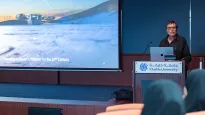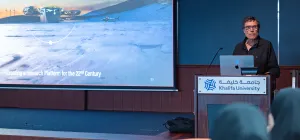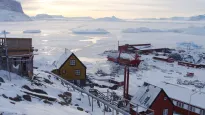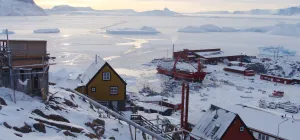Preben Van Overmeiren Explains Aerosols and Cloud Formation in Antarctica

Preben Van Overmeiren, a PhD candidate from Ghent University working for the EnVOC research group, conducted field work collecting organic and inorganic atmospheric particles for the CHASE project, which seeks to learn more about atmospheric circulation in the Southern Hemisphere and how atmospheric particles and gas phase compounds are transported to Antarctica. He also did field work for the CLIMB project, which is investigating how such particles influence cloud formation and precipitation in Antarctica.
What are the objectives of both CHASE and CLIMB projects?
CHASE is a project that started in 2017 with funding from the Belgian Federal Science Policy Office (BELSPO). It has four main partners: the Université Libre de Bruxelles (ULB), the Vrije Universiteit Brussels (VUB), Ghent University and the Royal Meteorological Institute of Belgium (KMI/IRM).
The project has two goals. Firstly, we’ve sampled the air in Antarctica to learn details about the chemical characteristics of atmospheric particles and gaseous compounds. Secondly, we’re investigating the atmospheric transport pathways, a task the Royal Meteorological Institute oversees. This year the project is coming to an end, but we’ve still got work to do to analyze the samples we’ve collected.
The CLIMB project continues on some of the discoveries made in previous projects such as CHASE as well as AEROCLOUD. CLIMB is coordinated by the Royal Meteorological Institute with partners Ghent University, KU Leuven and the Royal Belgian Institute for Space Aeronomy (IASB-BIRA). It focuses on taking measurements of meteorological, aerosol, cloud, and precipitation characteristics at the Princess Elisabeth Station and directly at the cloud level, on the edge on the Antarctic Plateau south of the Sør Rondane Mountains.
For both projects, we’ve been tracing different sources of both natural and anthropogenic aerosols and gases in Antarctica, how abundant pollutants are, and how they reach Antarctica. Yet while the CHASE project investigated a broad range of organic and inorganic species in the Antarctic atmosphere, the CLIMB project is investigating the role of atmospheric ice nuclei particles and organic compounds on cloud formation and precipitation. This information will be used in a regional climate model for the Dronning Maud Land area.
What methodologies did you use in each project?
Within CHASE, we used a few well-established methods such as using high volume samplers to sample particles and gases from the atmosphere. As the project was coming to an end this year, we had to collect all the passive samplers, which were installed on remote sites in the field four years ago, and bring them back to Belgium.
For CLIMB, a big challenge was to design and install active sampling equipment at high altitude (2350 m) and have it work with some batteries and a wind turbine year-round. We’ve managed the challenge quite well but installations like this are only possible due to IPF’s thorough support! At the station, we use small instruments such as the ice nuclei particle (INP) sampler to take samples of these important cloud-forming particles and remote sensing equipment like a CIMEL sunphotometer and a MAXDOAS (multi-axis differential optical absorption spectroscopy) instrument. On both sites, a unique VOC sampler is installed which monitors organic gases during the year.
Collecting atmospheric samples along a 250 km transect from the high plateaus to the coast has helped us compare the transport and composition of aerosols in inland highland regions to their transport and composition in lowland coastal regions.
For example, in the interior highlands, atmospheric circulation transports fine particles produced through mountain erosion. At the coast, atmospheric circulation brings in compounds from different landmasses surrounding Antarctica in the Southern Hemisphere: South America, Africa and Australia. At the coast, you tend to see more anthropogenic influence showing up in our samples.
Why are aerosols so important to the cloud formation process?
Various primary and secondary aerosols affect the microphysics of clouds. They act as nuclei for the formation of cloud droplets or small ice crystals. Clouds are an important factor in the earth’s albedo. They reflect a fraction of the sun’s radiation back into space, but they also reflect thermal radiation of the earth itself back towards the ground. The Intergovernmental Panel on Climate Change (IPCC) defined the effect of clouds on climate change as one of the biggest uncertainties. There is also a lot of indirect effects of aerosols on clouds which can have a positive or negative effect on the radiative energy budget.
Within CLIMB, we’re measuring ice-nuclei particles (INP), aerosol size and number concentration, volatile organic compounds (which can form secondary organic aerosols and precipitation) and cloud characteristics at PEA. At the aforementioned high-altitude site, we also try to measure aerosol size, precipitation and chemistry inside clouds. The location of PEA is interesting for such studies because you have easy access to higher altitude regions, it is influenced both by synoptic (large-scale) and katabatic (from the higher interior of the continent) meteorological regimes, and historically there aren’t a lot of similar studies done in this part of Antarctica.
As part of your fieldwork, you went on a field expedition to the coast for a few days. How did you like this experience?
We went to the coast driving in the Toyota Hilux, following in the path of two big Prinoth tractors. We could only travel at 15 – 20 km/h, so it took quite a while, but it was a great way to experience a different part of Antarctica.
At one point, the tractors left us to take care of some other business, and I was left alone to work with Henri Robert, the Deputy Station Manager. It was such an unforgettable experience to be doing fieldwork far away from civilization.
How was it travelling to Antarctica under COVID-19 restrictions?
The journey was hectic, but very well managed by the first crew. Poor weather conditions delayed our departure for Antarctica, so instead of spending two weeks in Cape Town, we spent three before we were able to start our mission.
It wasn’t all bad. The location where we were staying was delightful. I roomed together in a house with Alexis Merlaud (BIRA), who also contributed to the CLIMB project this season. I had never met him before, so it was a great opportunity to bond with a fellow scientist and share some ideas before the start of the season.
You stayed longer than expected this season. Why?
Normally I should have arrived at PEA mid-November and left mid-December before Christmas, which would have given me four or five weeks to conduct fieldwork. But as I said, our scheduled flight to Antarctica from Cape Town was delayed for more than a week due to poor weather conditions in Antarctica. After we arrived on the continent, I was part of the team that was stuck at Novo for 72 hours before being able to travel on to PEA, again due to poor weather conditions.
Since my mission this year included work for both the CHASE and CLIMB projects and I was already more than a week behind schedule when I finally arrived at PEA, I decided to stay longer and postpone my return flight until mid-January to make sure I could accomplish everything I was sent to do.
On the bright side, I got to celebrate Christmas and New Year’s in Antarctica for the first time at PEA with the crew. This was special for me! If there ever were one time in your life to spend Christmas and New Year’s in Antarctica, this was the year. COVID-19 has made it impossible to have large gatherings in Belgium. But in Antarctica, as we were all together isolated from the world in a COVID-free environment, it was more enjoyable.
Download





















